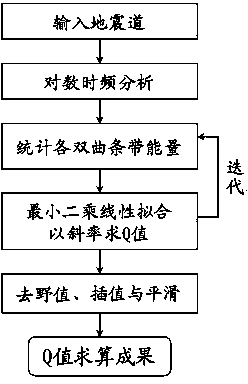Variable Q value calculation method based on unsteady state deconvolution
An unsteady, deconvolution technology, applied in the field of geophysical exploration, can solve the problem of limiting the idea of estimating the Q value of unsteady deconvolution, and achieve the effect of sufficient information and reliable estimation results
- Summary
- Abstract
- Description
- Claims
- Application Information
AI Technical Summary
Problems solved by technology
Method used
Image
Examples
Embodiment Construction
[0057] Such as figure 1 shown. Here, a numerical model test is used to illustrate the process of dividing hyperbolic strips and iteratively suppressing the influence of wavelets to obtain true slope characteristics. There is a three-layer reflection coefficient model in the model, which is divided into three layers, and the reflection coefficient amplitude level of the middle layer is 1 / 3 of that of the upper and lower layers. In the model test, the source wavelet with the main frequency of 40hz and the minimum phase is used to synthesize the seismic trace with the reflection coefficient sequence, and then Q=32 is given to attenuate the seismic trace in the time-frequency domain, thereby obtaining the final synthetic seismic Record. figure 1 In a, 20 hyperbolic band divisions (i.e., contours of the product of time and frequency) are schematically shown. If the data mean characteristics under each hyperbolic strip are firstly counted, the attenuation curve is established as ...
PUM
 Login to View More
Login to View More Abstract
Description
Claims
Application Information
 Login to View More
Login to View More - R&D
- Intellectual Property
- Life Sciences
- Materials
- Tech Scout
- Unparalleled Data Quality
- Higher Quality Content
- 60% Fewer Hallucinations
Browse by: Latest US Patents, China's latest patents, Technical Efficacy Thesaurus, Application Domain, Technology Topic, Popular Technical Reports.
© 2025 PatSnap. All rights reserved.Legal|Privacy policy|Modern Slavery Act Transparency Statement|Sitemap|About US| Contact US: help@patsnap.com



